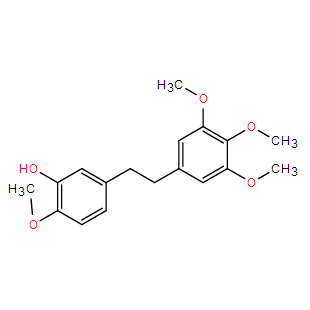| Cas No.: | 95041-90-0 |
| SMILES: | OC1=CC(CCC2=CC(OC)=C(OC)C(OC)=C2)=CC=C1OC |
| Formula: | C18H22O5 |
| M.Wt: | 318.36 |
| Purity: | >98%, Standard References Grade |
| Sotrage: | 4°C for 1 year, -20°C for more than 2 years |
| Description: | Erianin, often used as an antipyretic and analgesic agent, could inhibit IDO-induced tumor angiogenesis. |
| In Vitro: | Erianin is often used as antipyretic and analgesic agent. Erianin belongs to bibenzyl derivatives in structure, with the activity of anti-virus, anti-bacterial, as well as anti-benign prostatic hyperplasia. Erianin has obvious damage on 2LL-IDO cells, Erianin basically has no cytotoxicity on human normal liver cell line L02, and cell viability is maintained at around 85%[1]. Erianin inhibits the growth of HeLa cells and induces apoptosis in a dose‑ and time‑dependent manner, inducing cell cycle arrest at the G2/M stage. Erianin treatment also increases the expression of Bax and caspase‑3, but decreases levels of Bcl‑2 and phosphorylated‑ERK1/2[2]. |
| References: | [1]. Su C, et al. Erianin inhibits indoleamine 2, 3-dioxygenase -induced tumor angiogenesis. Biomed Pharmacother. 2017 Apr;88:521-528. [2]. Li M, et al. Erianin inhibits human cervical cancer cell through regulation of tumor protein p53 via the extracellular signal-regulated kinase signaling pathway. Oncol Lett. 2018 Oct;16(4):5006-5012. |

 DC Chemicals' products qualify for U.S. tariff exemptions. We guarantee no price increases due to customs duties and maintain stable supply, continuing to deliver reliable research solutions to our American clients.
DC Chemicals' products qualify for U.S. tariff exemptions. We guarantee no price increases due to customs duties and maintain stable supply, continuing to deliver reliable research solutions to our American clients.





















